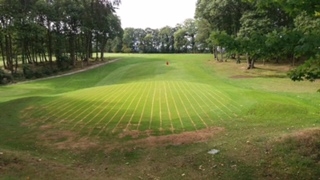The removal of excess soil water from a localised area on a fairway, football pitch or race course is going to require the installation of perforated land drainage pipes. The majority of piped systems today would be installed with the main drain off to the side of the playing surface or fairway with lateral piping connected to this main drain at evenly spaced intervals of 5, 7, or 10 metres.
For primary drainage work the Shelton Supertrencher+ range and Chain Trencher range is ideal.
Things to consider when planning your primary drainage work:
Pipe spacing and size
- Pipe spacing and diameter impacts upon the cost of carrying out primary sports pitch drainage work.
- Main drain pipes typically measure 100mm – 125mm in diameter
- Lateral pipes typically measure 60mm (in a 78mm trench) or 80mm (in 97mm trench).
- More closely spaced lateral pipes mean that smaller pipes can be used. This means that
- The trench widths are narrower therefore less aggregate is required to backfill and the ‘healing time’ for the surface is reduced
- The flow of water through the pipe is faster and this helps to keep them running clear
Aggregate choice
Where possible try to choose spherical aggregate material as they leave plenty of air spaces for water to flow through. Angular gravels tend to compact over time reducing the airspaces resulting in less efficient drainage. It is best to avoid aggregates with lots of fines as over time pipes can block, reducing the effectiveness of the drainage system.
Shelton recommends the use of Lytag®
There are many benefits to using Lytag®, including
- It can drain up to 10 times faster than an 8-10mm gravel
- Full consolidation occurs as the product is placed resulting in no further compaction during service and therefore no reduction in water flow rates through the particles
- It retains water in dry conditions which reduces striping which can occur over gravel due to lack of moisture in the aggregate
- It is half the weight of gravel per volume so reduces the weight of material being carted across site
- It shatters upon contact with mowers avoiding damage to the cutting blades
- It carries no Government Aggregate tax
There are lots of things to consider when deciding what type of sports field drainage system is right for you. Please don’t hesitate to contact us to discuss your particular problem and drainage requirements.
If you need to speed up the flow of soil water from your sports pitch surface a secondary drainage system can be superimposed over a piped primary drainage scheme.
Shelton offer four different secondary sports field drainage techniques:
- Sand slitting/Slit trench drainage
This is one of the most common forms of secondary drainage and involves the digging of 50mm wide gravel or sand filled slits spaced 1 – 2 metres apart. The slits are typically 250mm deep and are backfilled with 150mm gravel and 100mm of coarse sand.
This is most suited to systems installed during drier conditions, and when the grass is still growing to knit over the trenches.
- Gravel Banding Drainage
Closely spaced gravel bands (each approx 20 – 25mm wide) are injected in the playing surface by a vibrating channel opener. As no soil is removed, surface disturbance is minimal and play can resume immediately.
This is most suited to systems installed when the soil moisture is high usually during the winter months.
- System 25™
System 25™ is a trenching technique where 25mm wide trenches are dug by a high speed wheel. The arisings are conveyed to a trailer running alongside and simultaneously gravel or Lytag® is vibrated into the open trench in a one pass operation.
This is most suited to more sensitive areas like golf greens where minimal disturbance is essential and where recovery time should be as short as possible.
- Lightning Drain™
Trenches are dug 35mm wide, with arisings conveyed to a trailer running alongside. A 25mm perforated land drainage pipe is installed prior to backfilling with Lytag® in a one pass operation.
This is most suited to those areas that require the most efficient drainage coupled with minimal disturbance.
To help you to understand the differences between the various secondary drainage techniques and the cost implications, click here see the comparison chart
If you have any questions about your particular situation or require any advice please don’t hesitate to contact us.


